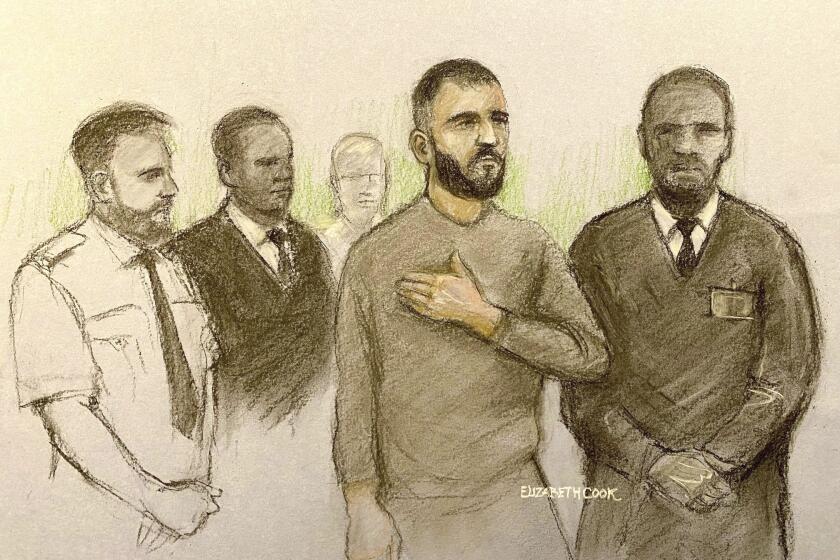Philippine Rebels Kill 10 in Ambush; Major Counteroffensive Readied
The Philippine military was poised for a major counteroffensive against Communist rebels on Friday after the death of one of Asia’s foremost news photographers, who was killed along with another Filipino journalist and eight soldiers in a Thursday night ambush by members of the Communist New People’s Army, 220 miles north of Manila.
Willie Vicoy, chief photographer for Reuters news agency in Manila, and reporter Pete Mabasa of the Manila Bulletin were the first journalists killed in the 17-year insurgency, which has claimed 655 lives since President Corazon Aquino assumed power Feb. 25.
In a written statement Friday afternoon, Aquino, who has been calling on the rebels to lay down their arms, said prospects for peace with the insurgents dimmed in the wake of the deaths, which, she added, “should make it plain to all that we cannot continue with this senseless violence without straining the bonds of unity and brotherhood among all Filipinos.”
Defense Minister Juan Ponce Enrile described the killings as “brazen and treacherous.” He warned in a nationally broadcast statement of “massive counter-action” in the wake of the ambush, the latest in a series of rebel attacks on military convoys that have claimed scores of lives in Enrile’s home province of Cagayan in the past week.
Military sources said the ambush took place while the two journalists were riding in a convoy of jeeps from a jungle base camp, where the military had displayed high-powered rifles and sophisticated arms confiscated from the rebels during earlier battles.
Convoy Flagged Down
Witnesses said a rebel soldier flagged down the convoy, and, as it slowed, at least 10 other heavily armed insurgents opened fire with rifles and grenades. Vicoy was hit in the back during the ensuing 45-minute gun battle and died 15 hours later.
“They fired the first shot,” Enrile said. “We did not.”
The ambush came amid a sharp increase this week in attacks by the New People’s Army, an armed force estimated in size at more than 15,000 regulars. Enrile had hinted three days earlier that the military was considering major “countermeasures.”
Among the soldiers killed was Enrile’s former security officer, Col. Alberto (Jack) Sudiacal, one of the initial 300 soldiers who sided with Enrile and military Chief of staff Gen. Fidel V. Ramos when they declared the revolt that led to the end of former President Ferdinand E. Marcos’ 20-year rule.
Noting that during the weeklong offensive in his home province alone, more than 64 soldiers, rebels and civilians had been killed, Enrile told reporters, “The frequency of encounters has lessened but the intensity has heightened.
To Take Countermeasures
“We will have to take countermeasures or initiate the effort to do so--at least until a cease-fire is in place,” Enrile said. He did not elaborate.
President Aquino pledged during her campaign earlier this year to attempt to end the insurgency within six months by calling for a cease-fire and initiating a program of amnesty for rebels who agree to lay down their arms.
No such amnesty program has begun, and there has been no official cease-fire, but several military commanders have said they are maintaining “a defensive posture” in their counterinsurgency efforts.
In his toughest language on the rebellion to date, though, Enrile said the battle cannot end without a political solution but that “we must be realistic enough to know these people who are mounting this insurgency are not really interested in reforms. . . . Their main aim is to seize power.”
Aquino herself said in her statement, “It pains me as the leader of our country to see our people so united in their hopes and aspirations for a more prosperous nation but severely divided on their means to attain it.” But she quickly added, “I am inclined to view this latest of killings as an aberration of a few misguided elements.”
Pressure for Solution
Nonetheless, the deaths of the two journalists is expected to increase the pressure on the Aquino Administration from the military and the national press to be more active in seeking a resolution of the rebellion by the Communist Party of the Philippines and its military wing.
Vicoy, 45, was a veteran combat photographer with an enormous following in the Philippines and throughout Southeast Asia. He spent four years in Vietnam working for United Press International. His photographs from that war were once nominated for the Pulitzer Prize. He was among the few photographers ever to have the same photograph on the covers of Time and Newsweek magazines the same week.
Vicoy also was one of the most prominent journalists chronicling Marcos’ prolonged decline--from the 1983 assassination of opposition leader Benigno S. Aquino Jr., the current president’s husband, to the military and civilian coup that drove Marcos into exile in February.
“If you want to be in the right place at the right time,” remarked another veteran photographer in the Philippines in 1983, “stand beside Willie.”
Rarely seen without his trademark Mao cap bearing a single red star in the center, Vicoy, who started with United Press International as a messenger in 1957, made it a practice to help young, aspiring Filipino photographers, and he became something of a guru among the Philippine press corps.
More to Read
Start your day right
Sign up for Essential California for news, features and recommendations from the L.A. Times and beyond in your inbox six days a week.
You may occasionally receive promotional content from the Los Angeles Times.






